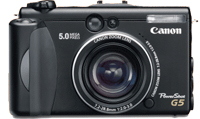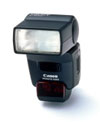
What camera does one need? I wanted something that:
- Was relatively small - no SLR as my first system;
- Had all the "pro" functions;
- Could take an external flash (I hate red eyes and dark rooms);
- Would fit my ~500 euro budget.
</UL>
It turned out that Nikon, Sony and Canon all had offerings that fit my
tastes; mostly because of the excellent experience of my monther with
the Canon PowerShot A70 (the old lady switched to digital before me ;-)),
I went with the Canon PowerShot G5 (while drooling about the Pro1 or one
of the SLR systems - later, when I have more cash ;-)). It also had a
faster lens than the competition, and I like fast lenses...
 I planned to buy a flash "some time", but after shooting the first couple of
parties with the built-in flash and getting red eyes (or, with red-eye
reducing turned on, delays in shooting because the camera was sending out
beams of light) and, worse, half-closed eyes because of the relatively slow
pre-flash, I sprang for a Canon Speedlite 420EX quite soon afterwards. It makes the
camera a bit top-heavy, to say the least, but gives beautiful results. The
combination is fully integrated - the flash zooms and purrs and supports stuff
like Slow Sync, Flash Exposure Lock, etcetera, and really is worth every cent
I spent on it (around 20000 eurocents, that is). Of course, I ordered the
matching Sto-fen Omnibounce with it to give me that "pro" look.
I planned to buy a flash "some time", but after shooting the first couple of
parties with the built-in flash and getting red eyes (or, with red-eye
reducing turned on, delays in shooting because the camera was sending out
beams of light) and, worse, half-closed eyes because of the relatively slow
pre-flash, I sprang for a Canon Speedlite 420EX quite soon afterwards. It makes the
camera a bit top-heavy, to say the least, but gives beautiful results. The
combination is fully integrated - the flash zooms and purrs and supports stuff
like Slow Sync, Flash Exposure Lock, etcetera, and really is worth every cent
I spent on it (around 20000 eurocents, that is). Of course, I ordered the
matching Sto-fen Omnibounce with it to give me that "pro" look.
Experience
I like the camera. It has more features than I care to list here (go to Digital Photography Review if you want all the gory details), but certainly has all the features I need - from complete manual control with RAW mode for landscapes etcetera, to fully automatic point-and-shoot mode. One of the best things is that it comes with an infrared remote control, which can be used as a wireless cable release for minimal vibrations when tripod-mounted.Tips
If you cycle through the various display modes when reviewing images, you should leave it at the most detailed mode - this includes a histogram, and the histogram is very important to evaluate your exposure when shooting. When you have the histogram mode as the last display mode and set your camera to show the last picture for a couple of seconds after shooting, you'll get the picture in histogram mode which allows you to immediately see whether exposure (and, to an extent, composition - the image is not very big in histogram display mode but large enough for a rough review) is correct.(product photo's - cough - borrowed - cough - from Canon, Inc. website)